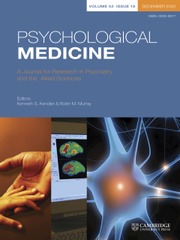Article contents
Predictive validity of psychosis risk models when applied to adolescent psychiatric patients
Published online by Cambridge University Press: 24 May 2021
Abstract
Several multivariate algorithms have been developed for predicting psychosis, as attempts to obtain better prognosis prediction than with current clinical high-risk (CHR) criteria. The models have typically been based on samples from specialized clinics. We evaluated the generalizability of 19 prediction models to clinical practice in an unselected adolescent psychiatric sample.
In total, 153 adolescent psychiatric patients in the Helsinki Prodromal Study underwent an extensive baseline assessment including the SIPS interview and a neurocognitive battery, with 50 participants (33%) fulfilling CHR criteria. The adolescents were followed up for 7 years using comprehensive national registers. Assessed outcomes were (1) any psychotic disorder diagnosis (n = 18, 12%) and (2) first psychiatric hospitalization (n = 25, 16%) as an index of overall deterioration of functioning.
Most models improved the overall prediction accuracy over standard CHR criteria (area under the curve estimates ranging between 0.51 and 0.82), although the accuracy was worse than that in the samples used to develop the models, also when applied only to the CHR subsample. The best models for transition to psychosis included the severity of positive symptoms, especially delusions, and negative symptoms. Exploratory models revealed baseline negative symptoms, low functioning, delusions, and sleep problems in combination to be the best predictor of psychiatric hospitalization in the upcoming years.
Including the severity levels of both positive and negative symptomatology proved beneficial in predicting psychosis. Despite these advances, the applicability of extended psychosis-risk models to general psychiatric practice appears limited.
Information
- Type
- Original Article
- Information
- Copyright
- Copyright © The Author(s), 2021. Published by Cambridge University Press
References
- 4
- Cited by

